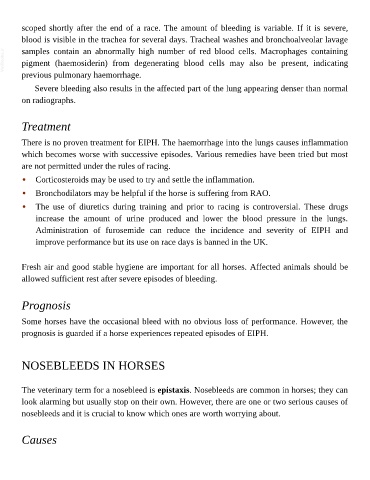Page 703 - The Veterinary Care of the Horse
P. 703
scoped shortly after the end of a race. The amount of bleeding is variable. If it is severe,
blood is visible in the trachea for several days. Tracheal washes and bronchoalveolar lavage
VetBooks.ir samples contain an abnormally high number of red blood cells. Macrophages containing
pigment (haemosiderin) from degenerating blood cells may also be present, indicating
previous pulmonary haemorrhage.
Severe bleeding also results in the affected part of the lung appearing denser than normal
on radiographs.
Treatment
There is no proven treatment for EIPH. The haemorrhage into the lungs causes inflammation
which becomes worse with successive episodes. Various remedies have been tried but most
are not permitted under the rules of racing.
• Corticosteroids may be used to try and settle the inflammation.
• Bronchodilators may be helpful if the horse is suffering from RAO.
• The use of diuretics during training and prior to racing is controversial. These drugs
increase the amount of urine produced and lower the blood pressure in the lungs.
Administration of furosemide can reduce the incidence and severity of EIPH and
improve performance but its use on race days is banned in the UK.
Fresh air and good stable hygiene are important for all horses. Affected animals should be
allowed sufficient rest after severe episodes of bleeding.
Prognosis
Some horses have the occasional bleed with no obvious loss of performance. However, the
prognosis is guarded if a horse experiences repeated episodes of EIPH.
NOSEBLEEDS IN HORSES
The veterinary term for a nosebleed is epistaxis. Nosebleeds are common in horses; they can
look alarming but usually stop on their own. However, there are one or two serious causes of
nosebleeds and it is crucial to know which ones are worth worrying about.
Causes

